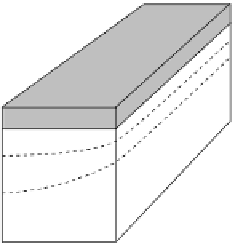Geoscience Reference
In-Depth Information
(a)
Mantle flow
Figure 9.38.
Two possible
mechanisms for the
crustal thickness along
fast-spreading ridges to
vary little, whereas along
slow-spreading ridges it
decreases towards
segment ends. (a) Mantle
flow is two-dimensional
beneath fast-spreading
ridges and
three-dimensional
beneath slow-spreading
ridges. (From Lin and
Phipps Morgan, The
spreading rate
dependence of
three-dimensional
mid-ocean ridge gravity
structure,
Geophys. Res.
Lett.
,
19
, 13-16, 1992.
Copyright 1992 American
Geophysical Union.
Reproduced by
permission of American
Geophysical Union.)
(b) Mantle flow is
three-dimensional both
beneath fast-spreading
ridges and beneath
slow-spreading ridges,
with axial flow in the crust
at fast-spreading ridges.
Reprinted with
permission from
Nature
(Bell and Buck,
Nature
,
357
, 583-6) Copyright
1992, Macmillan
Magazines Ltd.)
Fast-spreading ridge
Slow-spreading ridge
Crust
Mantle
(b)
Crustal flow
Hot axial crust
Cold axial crust
Crust
Mantle
of transform fault are better understood, this issue probably will not be fully
resolved.
The age contrast across transform faults varies greatly (Table 9.4). This means
that the thickness of the lithosphere changes across the fault (see Section 7.5.2).
A37Ma age contrast across the St Paul transform fault in the North Atlantic
implies an increase in lithospheric thickness from perhaps 7 km at the ridge axis
to over 60 km, almost an order of magnitude. It is this presence of young, hot
lithosphere next to old, cold, thick lithosphere which probably controls much of
the topography, magmatism and morphology of the transform faults. The nodal
basins are considered to be the result of a thermally induced loss of viscous head
in the rising asthenosphere beneath the ridge axis, where the ridge is truncated
by the older, cold thick lithosphere.
Figure 9.34 illustrates the two extremes in transform-fault structures: large-
offset slow slipping and large-offset fast slipping. It is important to realize that
it is not the length of the offset but the age difference across the transform
which controls the magnitude of the topography and the type of transform fault
formed. In the slow-slipping example, the faulting takes place across a narrow
zone because the thick, cold lithosphere places severe mechanical constraints on




























































































